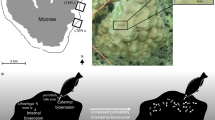Abstract
At Isla del Caño, Costa Rica, the main reef bioeroders are species of the boring bivalve, Lithophaga. These mussels are abundant in virtually all colonies of the main framework builder, Porites lobata. The bivalves have a significant effect on the strength of the colonies which, at a maximum compressive and bending strength of 20 and 5 MN/m2, respectively, are already the lowest ever measured for corals. Presence of bivalve boreholes is inversely logarithmically associated with coral strength, with the greatest decrease in strength occurring with the first boreholes.
Similar content being viewed by others
References
Acker KL, Risk MJ (1985) Substrate destruction and sediment production by the boring sponge, Cliona caribbaea on Grand Cayman Island. J Sediment Petrol 55:705–711
Bergman KM, Elner RW, Risk MJ (1982) The influence of Polydora websteri borings on the strength of the shell of the sea scallop, Placopecten magellanicanus. Can J Zool 60:2551–2556
Chamberlain JA (1978) Mechanical properties of coral skeleton: compressive strength and its adaptive significance. Palaeobiology 4:419–435
Constantz BR (1986) The primary surface area of corals and variations in their susceptibility to diagenesis. In: Schroeder JH, Pursers B (eds) Reef diagenesis. Springer, Berlin Heidelberg New York, pp 53–76
Dana JD (1853) On coral reefs and islands. Putnam, New York
Dudgeon D, Morton B (1981) The coral associated Mollusca of Tolo Harbour and Channel, Hong Kong. In: Morton E, Tseng CK (eds) Proceedings of the First International Marine Biological Workshop on the Marine Flora and Fauna of Hong Kong and Southern China, pp 627–650
Easton WH, Olsen EA (1976) Radiocarbon profile of Hanauma Reef, Oahu, Hawaii. Bull Geol Soc Am 87:711–719
Gardiner SJ (1903) The Maldive and Laccadive Groups, with notes on other coral formations in the Indian Ocean. Fauna Geogr Maldive Laccadive Archipel 1:333–341
Goreau TF, Hartman WD (1966) Sponge: effect on the form of reef corals. Science 151:343–344
Graus RR, Chamberlain JA, Boker AM (1977) Structural modification of corals in relation to waves and currents. In: Frost SH, Weiss MP, Saunders JB (eds) Reefs and related carbonates — ecology and sedimentology. Am Assoc Petrol Geol Stud Geol 4:135–153
Guzman H (1986) Estructura de la comunidad arrecifal de la Isla del Caño, Costa Rica, y el effeto de perturbaciones naturales severas. M Sc thesis, Universidad de Costa Rica
Hallock P, Schlager W (1986) Nutrient excess and the demise of coral reefs and carbonate platforms. Palaios 1:389–398
Hopley D (1982) The geomorphology of the Great Barrier Reef: quaternary development of coral reefs. Wiley, New York
Hopley D, MacLean R, Marshall JF, Smith AS (1978) Holocene-Pleistocene boundary in a fringing reef: Hayman Island, North Queensland. Search 9:323–325
Hopley D, Slocombe AM, Muir F, Grant C (1983) Nearshore fringing reefs in North Queensland. Coral Reefs 1:151–160
Hughes T (1987) Skeletal density and growth form of corals. Mar Ecol Prog Ser 35:259–266
Johnson DP, Risk MJ (1987) Fringing reef growth on a terrigenous mud foundation, Fantome Island, central Great Barrier Reef, Australia. Sedimentology 34:275–287
Kobluk DR, Botther DJ, Risk MJ (1977) Disorientation of Paleozoic hemispherical corals and stromatoporoids. Can J Earth Sci 14:2226–2231
Macintyre IG, Glynn P (1976) Evolution of a modern Caribbean fringing reef, Galeta Point, Panama. Bull Geol Soc Am 60:1054–1072
Otter GW (1937) Rock-destroying organisms in relation to coral reefs. Great Barrier Reef Exped Rep 1:323–352
Risk MJ, Muller HR (1983) Porewater in coral heads: evidence for nutrient regeneration. Limnol Oceanogr 28:1004–1008
Rose CS, Risk MJ (1985) Increase in Cliona deletrix infestation of Montastrea cavernosa heads on an organically polluted portion of the Grand Cayman fringing reef. PSZNI Mar Ecol 6:345–367
Schuhmacher H, Plewka M (1981) The adaptive significance of mechanical properties versus morphological adjustments in skeletons of Acropora palmata and Acropora cervicornis (Cnidaria, Scleractinia). Proc 4th Int Coral Reef Symp 2:121–128
Scoffin TP, Stoddart DR (1978) Nature and significance of microatolls. Philos Trans R Soc London B Ser 284:99–122
Scott PJB, Cope M (in press) Tolo revisited: a resurvey of the corals of Tolo Harbour and Channel siz years and half a million people later. In: Morton B (ed) Proceedings of the Third International Workshop on the Marine Flora and Fauna of Hong Kong and Southern China. Hong Kong University Press, Hong Kong
Stephenson W, Searles RB (1960) Experimental studies on the ecology of intertidal environments at Heron Island I. Exclusion of fish from beach rock. Aust J Mar Freshw Res 11:241–267
Storer RA (1986) Standard test methods for cold crushing strength and modulus of rupture of insulating firebrick C 93-84. In: Storer RA (ed) 1986 Annual Book of ASTM Standards 15.01:51–54
Storer RA (1987) Standard methods of sampling and testing brick and structural clay tile C 67–86. In: Storer RA (ed) 1987 Annual Book of ASTM Standards 04.05:51–61
Tunnicliffe V (1979) The role of boring sponges in coral fracture. Colloq Int CNRS 291:309–315
Tunnicliffe V (1982) The effects of wave-induced flow on a reef coral. J Exp Mar Biol Ecol 64:1–10
Vosburgh F (1977) The response to drag of the reef coral, Acropora reticulata. Proc 3rd Int Coral Reef Symp 1:477–482
Wainwright SA (1962) An authozoan chitin. Experientia 18:18–19
Wainwright SA, Biggs WD, Currey JD, Gosline JM (1976) Mechanical design in organisms. Arnold, London, 423 pp
Weiner S, Traub W, Lowenstam HA (1982) Organic matrix in calcified exoskeletons. In: Westbroek P, Jong EW de (eds) Biomineralization and biological metal accumulation: biological and geological perspectives. 4th International Symposium on Biomineralization, Renesse, The Netherlands Reidel, Dordrecht, pp 205–224
Author information
Authors and Affiliations
Rights and permissions
About this article
Cite this article
Scott, P.J.B., Risk, M.J. The effect of Lithophaga (Bivalvia: Mytilidae) boreholes on the strength of the coral Porites lobata . Coral Reefs 7, 145–151 (1988). https://doi.org/10.1007/BF00300974
Accepted:
Issue Date:
DOI: https://doi.org/10.1007/BF00300974




